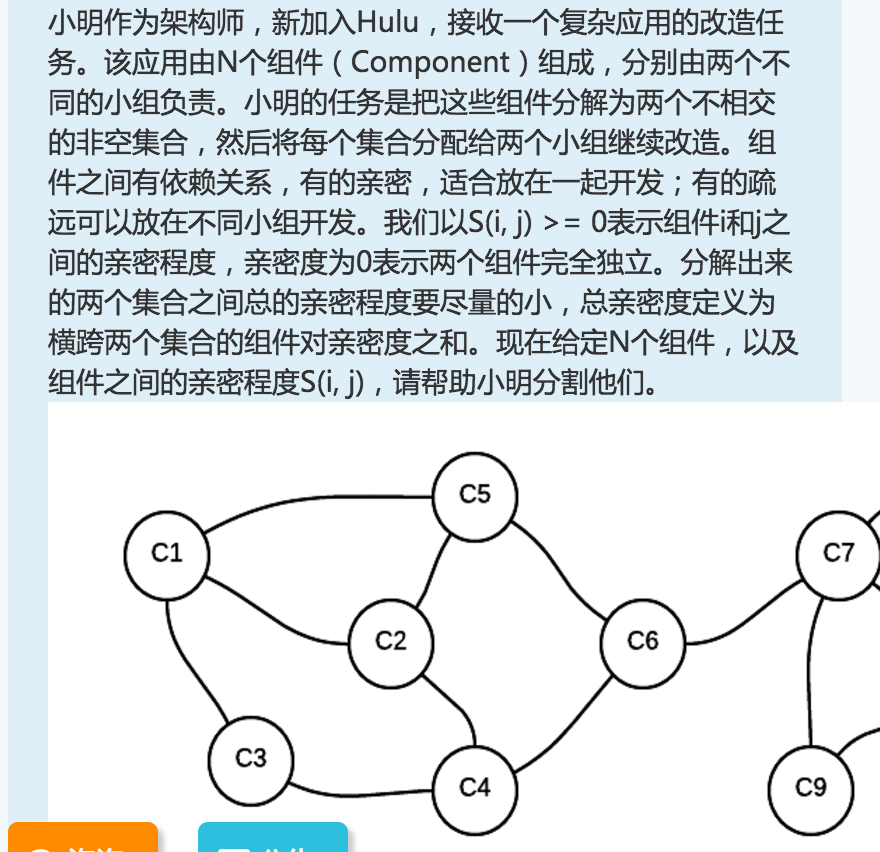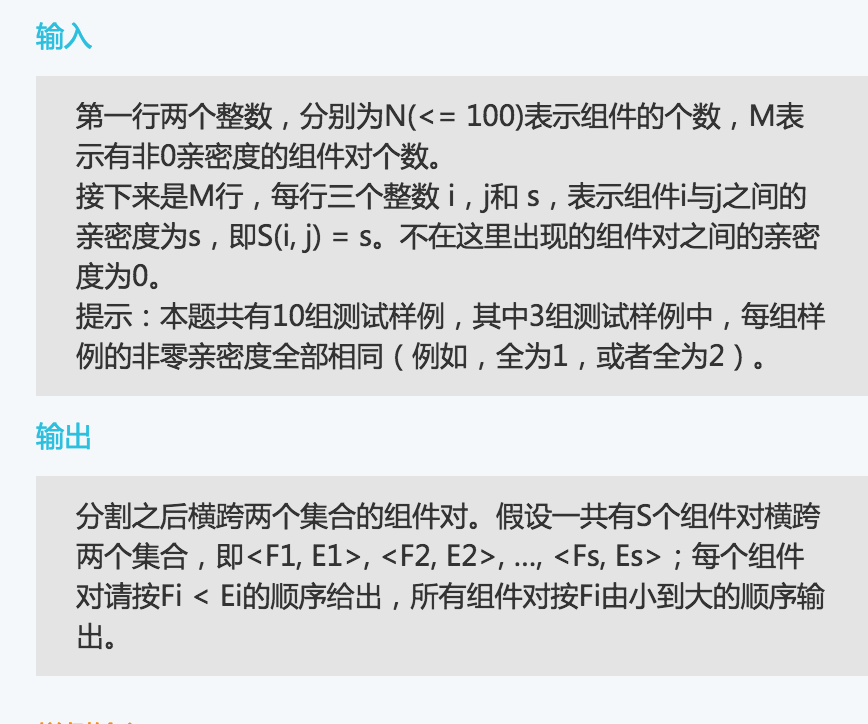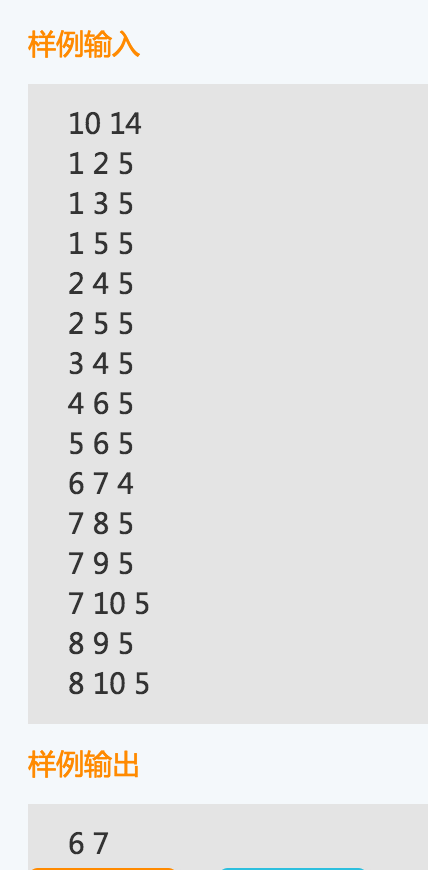


a
看完题目,根本没想法,暴力的复杂度是指数级别的,枚举所有的集合,当时有点紧张,暴力的都没写,其实没思路的
时候最好写暴力的算法,骗点分就可以了。后来,看了牛客网上大神的思路,然后学习了下最大流最小割的方法,这题的
做法就是枚举源点和汇点,跑最大流算法,然后用流量更新答案,同时保存最小割,最后输出,就可以了。
简单写了下,也是无法实际运行去判断正误。
对最大流最小割的思路理解的不是很透彻,不知道怎么求最小割,没有做这方面的练习。

1 #include <iostream> 2 #include <cstdio> 3 #include <cstring> 4 #include <queue> 5 #include <cmath> 6 #include <algorithm> 7 using namespace std; 8 9 const int mn=422; 10 const int mm=10000; 11 const double oo=999999; 12 int node, st, sd, edge; 13 int reach[mm], nxt[mm]; 14 double flow[mm]; 15 int adj[mn], work[mn], dis[mn], que[mn], cap[mn]; 16 17 inline void init(int _node, int _st, int _sd) 18 { 19 node=_node, st=_st, sd=_sd; 20 for(int i=0; i<node; i++) 21 adj[i]=-1; 22 edge=0; 23 } 24 25 inline void addedge(int u, int v, double c1, double c2) 26 { 27 reach[edge]=v, flow[edge]=c1, nxt[edge]=adj[u], cap[edge] = c1, adj[u]=edge++; 28 reach[edge]=u, flow[edge]=c2, nxt[edge]=adj[v], cap[edge] = c2, adj[v]=edge++; 29 } 30 31 bool bfs() 32 { 33 int i,u,v,l,r=0; 34 for(i=0; i<node; ++i)dis[i]=-1; 35 dis[que[r++]=st]=0; 36 for(l=0; l<r; ++l) 37 for(i=adj[u=que[l]]; i>=0; i=nxt[i]) 38 if(flow[i]&&dis[v=reach[i]]<0) 39 { 40 dis[que[r++]=v]=dis[u]+1; 41 if(v==sd)return 1; 42 } 43 return 0; 44 } 45 typedef pair<int, int> pii; 46 vector<pii> getCut() { 47 int l, r = 0, u, v; 48 que[r++] = st; 49 vector<pii> res; 50 vector<bool> in(node, 0); 51 for (l = 0; l < r; l++) { 52 if(in[que[l] ]) continue; 53 in[que[l] ] = 1; 54 for (int i = adj[u = que[l]]; i >= 0; i = nxt[i]) { 55 //cout << reach[i] <<" "; 56 if(flow[i] != 0) { 57 que[r++] = reach[i]; 58 } else { 59 int x = u, y = reach[i]; 60 if(x > y) swap(x, y); 61 res.push_back({x, y}); 62 } 63 } 64 //cout << endl; 65 } 66 return res; 67 } 68 69 double dfs(int u,double exp) 70 { 71 if(u==sd) return exp; 72 double tmp; 73 for(int &i=work[u],v; i>=0; i=nxt[i]) 74 if(flow[i]&&dis[v=reach[i]]==dis[u]+1&&(tmp=dfs(v,min(exp,flow[i])))>0) 75 { 76 flow[i]-=tmp; 77 flow[i^1]+=tmp; 78 return tmp; 79 } 80 return 0; 81 } 82 83 double Dinic() 84 { 85 double max_flow=0, flow; 86 while(bfs()) 87 { //cout << "asd" << endl; 88 for(int i=0; i<node; i++) work[i]=adj[i]; 89 while(flow=dfs(st,oo)) { 90 //cout << flow << endl; 91 max_flow+=flow; 92 } 93 } 94 return max_flow; 95 } 96 //上面从网上搜索的,注意修改顶点数,边数,这里边数是2倍,注意节点的编号,从0开始。 97 //当然,你必须知道dinic算法的逻辑才行。 98 struct Node { 99 int x, y, v; 100 }; 101 int main() 102 { 103 freopen("test.in", "r", stdin); 104 int n, m; 105 scanf("%d%d",&n,&m); 106 int x, y, v; 107 vector<Node> e; 108 for (int i = 0; i < m; i++) { 109 scanf("%d%d%d", &x, &y, &v); 110 e.push_back({x, y, v}); 111 } 112 int res = INT_MAX; 113 vector<pii> p; 114 for (int i = 1; i <= n; i++) { 115 for (int j = i + 1; j <= n; j++) { 116 init(n + 1, i, j); 117 for (Node t : e) { 118 addedge(t.x, t.y, t.v, t.v); 119 } 120 double ans=Dinic(); 121 if(ans < res) { 122 res = ans; 123 p = getCut(); 124 } 125 } 126 } 127 //cout << res << endl; 128 sort(p.begin(), p.end()); 129 for (pii t : p) 130 cout << t.first << " " << t.second << endl; 131 return 0; 132 }
